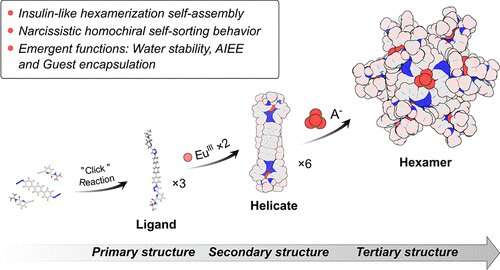Hexameric lanthanide-organic capsules with tertiary structure, emergent functions

Metal-directed assemblies have become a widely used approach in designing sophisticated and multifunctional artificial complexes. Numerous discrete metal-organic architectures have been constructed, and their properties and functions are mainly derived from the primary and secondary structures of the building blocks.
In virtue of the analogous coordination behavior similar to that of transition metals, anion-templated synthesis and anion-directed assembly have been used in the design of unique supramolecular architectures. In the presence of strong anion-coordinating groups, anion-directed assembly will be used to program the hierarchical aggregation of metallasupramolecular complexes toward higher-ordered architectures.
In a study published in the Journal of the American Chemical Society, a research group led by Prof. Sun Qingfu from Fujian Institute of Research on the Structure of Matter of the Chinese Academy of Sciences reported the first example of an anion-driven aggregation of a lanthanide triple helicate assembly toward a 4-nm-diameter lanthanide-organic hexamer.
Intriguing chiral-sorting aggregation between the P-ΔΔ and M-ΛΛ stereo-isomers of helicates gives rise to the formation of a pair of (P-ΔΔ)6 and (M-ΛΛ)6 enantiomers for hexamers. Increased water-stability and aggregation-induced emission enhancement have been confirmed in the united hexamer.
While helicate is non-porous, emergent guest-encapsulation function has been realized in the central chiral pocket of hexamer defined by six ligand panels from each helicate, which not only can uptake small molecules, but also show enantioselectivity toward chiral terpene drugs.
In theory, the hexamerization from two kinds of helicates can statistically give 24 types of stereoisomers. However, the researchers observed only homochiral enantiomers of (P-ΔΔ)6 and (M-ΛΛ)6 in solid state. The high-fidelity chiral self-sorting aggregation in solution was also verified by nuclear magnetic resonance (NMR) differentiation experiment Δ-TRISPHAT.
With the aggregation of helicate to hexamer, the emission intensity displayed a 2.5 times enhancement, along with the photoluminescent quantum yields increased from initially 22.8% to 46.2%.
Meanwhile, structural integrity of lanthanide supramolecular architectures is of key importance to their biological applications. When water content increased to 17%, a large amount of white precipitate occurred in case of helicate along with the disappearance of the signals arising from the helicate on 1H NMR. Under 365 nm ultraviolet (UV) lamp, the solution witnessed the disappearance of the characteristic red EuIII luminescence and the blue emission from free ligand, indicating the dissociation of the helicate.
In contrast, for hexamer, its signals remained on NMR even with over 50% water content, where the solution still displayed strong red light under UV irradiation.
In addition to water stability and Aggregation-Induced Emission Enhancement (AIEE) property, hexameric capsule also showed emergent guest-uptake functions. Due to the racemic nature of the capsule, the researchers have noticed diastereomeric selectivity when they used enantiopure terpenoids as guests.
This study not only provides a feasible strategy for constructing more sophisticated and multifunctional lanthanide-organic materials, but also sheds light on the self-assembly processes in nature.
More information: Xiao-Qing Guo et al, Hexameric Lanthanide–Organic Capsules with Tertiary Structure and Emergent Functions, Journal of the American Chemical Society (2021). DOI: 10.1021/jacs.1c01168
Journal information: Journal of the American Chemical Society
Provided by Chinese Academy of Sciences





















